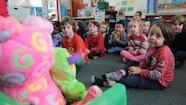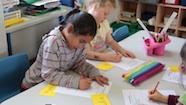Anne uses everyday opportunities to make technology connections with her year 3 class.
Technology isn’t just about making things
Transcript
At present, our year three's still have the main focus around change, which has been our topic for the whole year, and we moved toward sustainability.
First, sustainability is a student-led inquiry, so the inquiry can go off in any direction. So the planning for this year has been around the different areas it might go, and obviously technology is one of the key areas that we have looked at.
The component that stands out for us under the theme of sustainability is the Characteristics of technology. When I start teaching technology now, I always start with the nature strand as that’s where students learn what technology is. The indicators that have stood out, and that we were going to focus around, are the relationships with technology and the made, natural, and social world – identifying environmental issues that may have influenced particular technological practices and describing examples when technology has had a positive and negative impact on the environment.
A lot of the teaching around technology has fallen out through the children’s questions and their wonderings that they have had. It has been very good to see the students make connections with what they did previously at the start of the year around the made world and the natural. They can see that the things that we have made for ourselves to improve our lives now, has actually had a huge impact on the environment that they now need to live in and actually need to do something to sustain it sustain it for themselves and for their future families.
The sustainability area ended up been broken down into three different parts. The first part, the children decided that they wanted to have their questions answered around greenhouse gases and global warming. From the research we did, it led on into doing some reading and finding out about alternative energy sources which led one of my student to come up with some great words, “We need to spread the word”.
We read an article from the Connected series called "Wind Power", which led the children to then take action. The keywords at the end of the article are the ones that we used to take us further – “One thing we can do now to help the situation is to use less energy whenever possible – it’s easier and cheaper to use less energy than to generate more”.
The children came up with a range of ideas of how they could spread the word, and from that went off to their own directions and created powerpoints, posters. They decided that the school also needed to do something, and so surveyed the teachers and made rather a lot of “turn of the light” switches. One of the other areas was to make a little sign to go above all the switches in the school, saying “Turn me off”, so they are very visible around our school now.
I no longer see technology as a unit of work that needs to be taught and it doesn’t have to be a making process. The components are really easy to slot through your cross-curricular links and slot into the inquiry approach.
A lot of it, the children can make connections to very quickly as it is the world they live in, as it is the technology that they use, and they can see the impact that it has when they do just have a throwaway item.
Related videos
New entrants identify the made world (03:14)
New entrants explore what technology is with teacher Jill Harper.
Year 1–2 technologists design for a purpose (03:52)
Students in years 1 and 2 discuss with their teacher why technologists make things out of different materials.
Year 1–2 future technologists (02:06)
Kathy Chandler and her year 1–2 students discuss technological outcomes and what technologists do.
Cars are technological outcomes (03:53)
James Mawson explores cars as technological outcomes with his year 2 class.




